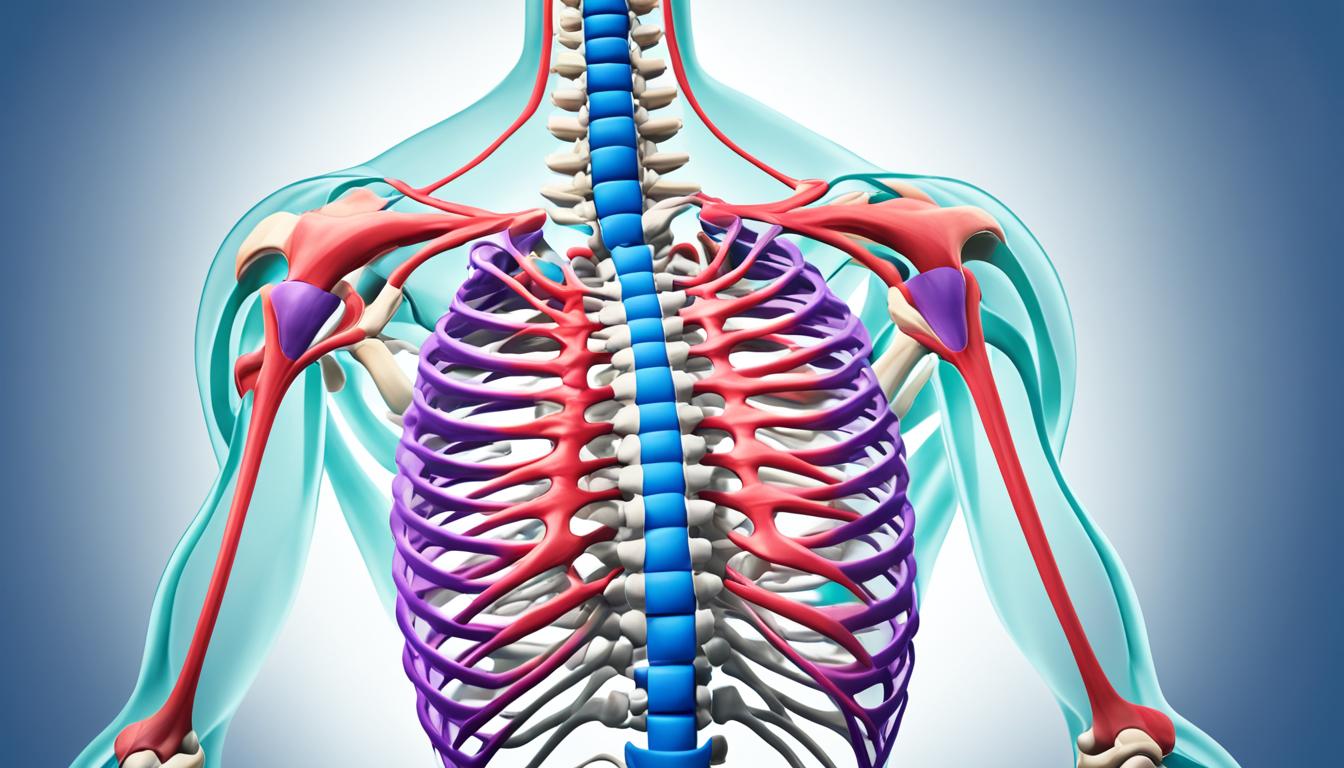Costochondritis is when the cartilage that links the ribs to the breastbone gets inflamed. It leads to pain in the chest, ribs, or sternum area. The exact reason for costochondritis is unclear. But, it’s often linked to overuse, injury, or illnesses affecting the respiratory system.
Doctors typically diagnose costochondritis by checking your health history and a physical exam. They also look at other possible reasons for your chest pain. Treatment can be simple, like rest and managing pain. Or, it can involve more advanced options such as stem cell therapy.
Key Takeaways:
- Costochondritis involves inflammation in the ribs’ cartilage, causing chest pain.
- The exact cause is not always clear, but it’s often due to overuse, injury, or respiratory illnesses.
- Diagnosis is through reviewing your health history, a physical exam, and eliminating other causes.
- Treatments include rest, pain management, and options like stem cell therapy.
- To prevent costochondritis, focus on good posture, avoid overuse, and treat respiratory infections early.
Costochondritis Symptoms and Diagnosis
Costochondritis causes inflammation in the cartilage between ribs and breastbone. It leads to chest pain, which can feel sharp, stabbing, or achy. This pain is usually right around the chest area.
People with this condition may feel sore when touched there. The pain can get worse with movements like breathing deeply or coughing. Sometimes, you might see a little swelling or redness too.
Medical History Review and Physical Examination
Doctors need to know about the patient’s chest pain in detail to diagnose costochondritis. They ask about where it hurts, how intense it is, and how long it’s been there. They also look for any recent injuries or sicknesses that might explain the pain.
A physical exam is done to check for tenderness and swelling. The doctor presses gently on the chest and watches how the patient reacts. This helps the doctor figure out how sore the area is.
Imaging Tests and Ruling Out Other Causes
Doctors sometimes order imaging tests to get a better look. X-rays, CT scans, or MRIs can show the cartilage clearly. This helps rule out heart, lung, or gut problems.
It’s important to make sure the chest pain isn’t from something else. EKGs or lung tests might be done. It’s all part of checking for other health issues.
After a full check-up, including history, exam, and tests, doctors can diagnose costochondritis.
| Symptoms | Description |
|---|---|
| Tenderness | Pain and sensitivity at the affected area |
| Worsening pain with movement | Pain intensifies with activities such as deep breathing or coughing |
| Swelling | In some cases, mild inflammation or swelling may be present |
| Pain relief with rest | Pain subsides when resting or avoiding movements that aggravate the condition |
| Pain in adjacent areas | Pain may radiate to nearby areas, such as the shoulders or arms |
Costochondritis Causes, Risk Factors, and Prevention
The exact cause of costochondritis is unknown. Yet, several factors can make it more likely.
- Chest injury, like from a fall, can inflame the costochondral joints.
- Doing things like lifting heavyweights or hard exercises can irritate the cartilage too.
- Sometimes, viral or bacterial chest infections start costochondritis.
- Joint or tissue diseases such as rheumatoid arthritis increase the risk.
- Bad posture and certain risks, like past chest injuries or infections, also play a part.
Prevention includes keeping a good posture and avoiding chest strain. Yet, it can still happen without clear reasons.
Prevention Strategies for Costochondritis
To avoid or stop costochondritis from coming back, there are some helpful steps to take.
- Sit and stand tall to support your spine and lower chest stress.
- Rest when doing activities with a lot of chest motions or lifting to avoid too much pressure.
- Deep breathing eases chest muscle tension and cuts down on inflammation risk.
- Exercise your chest with things like push-ups can make these muscles and joints stronger.
- Being active, eating well, and managing stress are essential for your whole body’s muscle health.
- If you get a chest infection, get it treated quickly to avoid costochondritis.
| Risk Factors for Costochondritis |
|---|
|
Costochondritis Treatment and Stem Cell Therapy
Treating costochondritis involves using medications, therapies, and home care. Over-the-counter drugs like ibuprofen help with pain and swelling. But, if it’s more severe, you might need stronger pain medicines or shots in the painful area.
Physical therapy can also improve your symptoms. This includes exercises to fix your posture and strengthen your muscles. And, using heat or cold packs on the chest area can ease pain and reduce swelling.
If simple treatments don’t work, surgery could be an option. This includes removing cartilage or doing nerve blocks between the ribs. These surgeries aim to stop inflammation and pain in the chest area for a long time.
But, your habits and what you do at home can really make a difference in treating costochondritis. Rest, avoid activities that cause more pain, and make sure you sit or stand straight. It’s also key to prevent this condition by watching your posture, not doing repetitive movements, and treating chest colds early.
New treatments like stem cell therapy show hope for costochondritis. Treatments with platelet-rich plasma (PRP) aim to reduce swelling and help you heal. They use your own cells to kickstart your body’s healing process. Though more studies are necessary, the start looks good for this kind of therapy.

